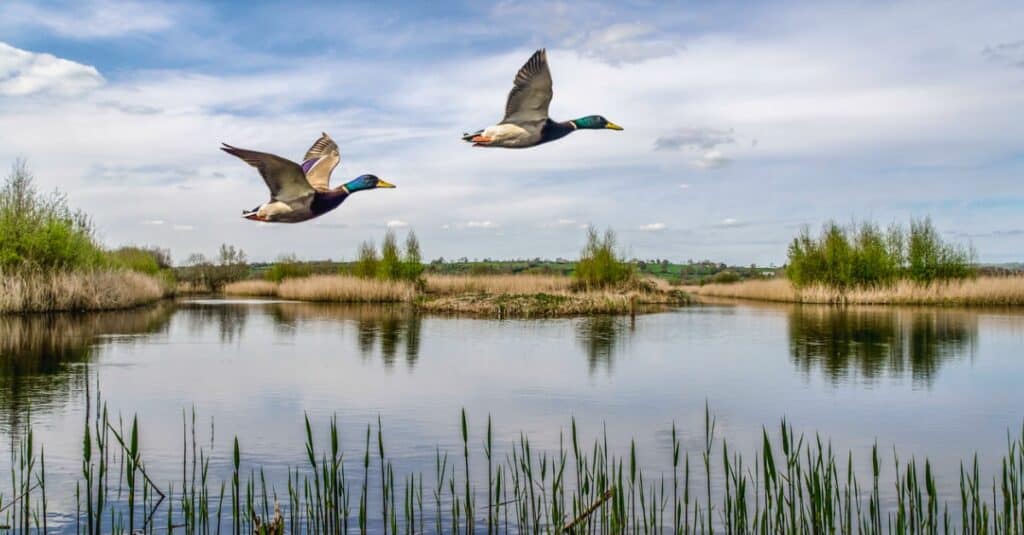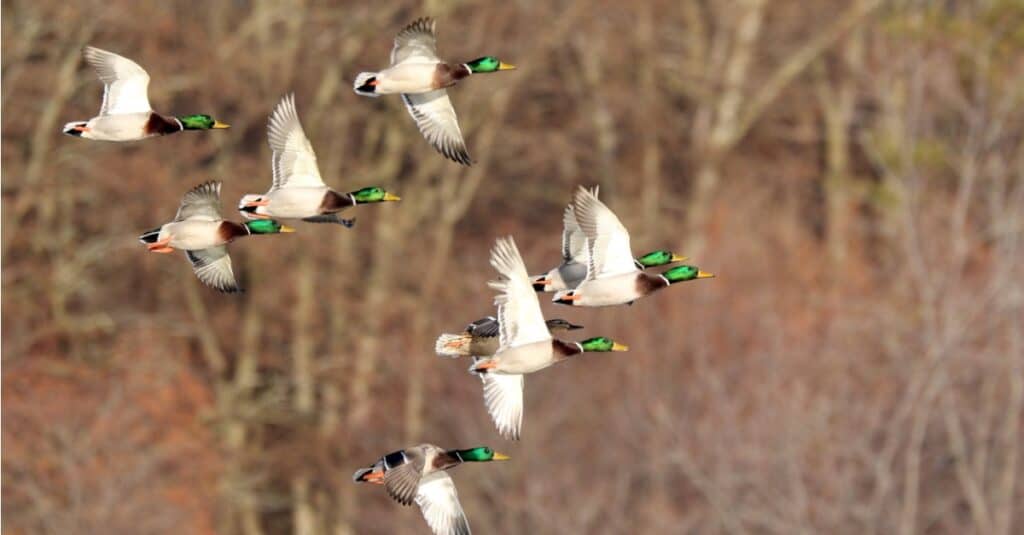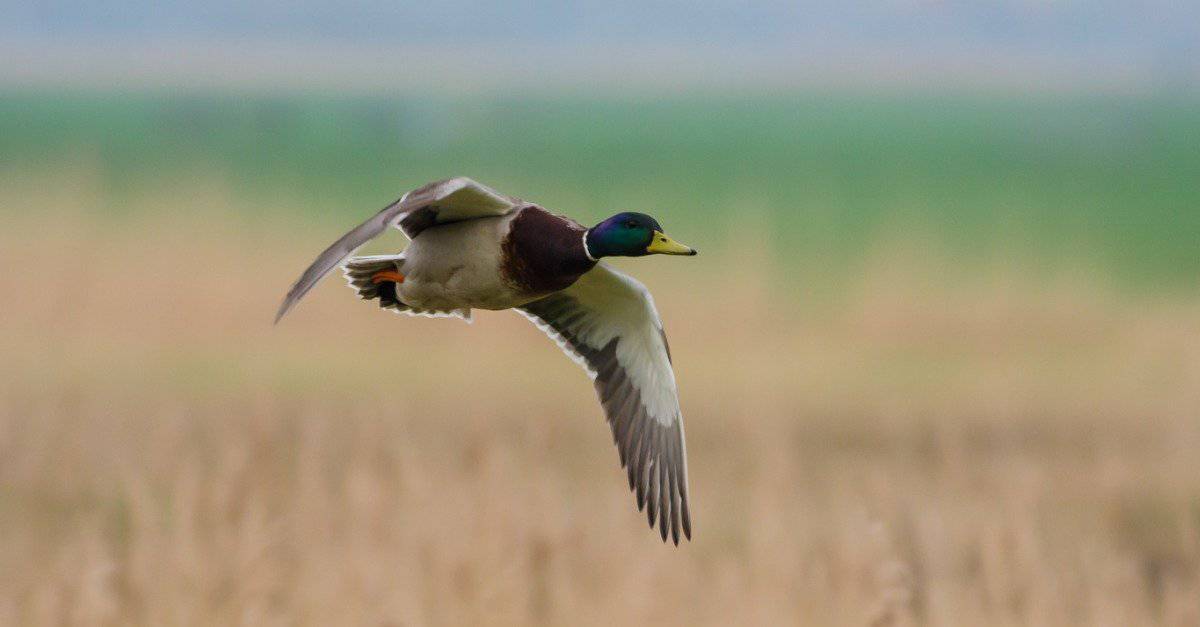Did you know there are over 100 species of duck? It’s true! All ducks have wings so it may seem natural to think they can all fly. The truth is that some ducks can fly while others can’t take flight. Keep reading to find the answer to the question: Can ducks fly? In addition, learn about the different types of ducks within the species along with how fast and far some can fly.
Can Ducks Fly?
Some types of ducks can fly. For example, the Muscovy duck and the Khaki Campbell duck can take flight. Alternatively, the Pekin duck as well as the Rouen and the Cayuga cannot fly.
Why Are Some Ducks Unable to Fly?
The main reason why some of these feathered animals are unable to fly relates to their body weight. They are too heavy to get off the ground. Many Pekin are raised and sold as food. They are given a diet that increases their body weight making it impossible for them to leave the ground. A smaller, lighter Pekin duck may be able to take flight for a few feet, but it won’t be able to soar like a wild mallard.
Some types of ducks have very small wings that don’t allow them to take flight. Though they can’t fly, you may see the Pekin or Cayuga duck flutter their wings and hop around on the ground. Another reason why some ducks don’t fly has to do with how they are raised. A Pekin is a domestic duck. In other words, these ducks are bred and raised by humans. Because they live in captivity, they don’t need to migrate to warmer weather like wild birds. Domestic ducks like the Pekin do not need to fly.

©iStock.com/Nathanx1
What Are the Different Types of Ducks?
Ducks can be divided into three categories. There are diving, dabbling, and domestic ducks.
Have you ever seen a duck swimming on the surface of a lake or pond then disappear below the surface? If the answer is yes, you’ve seen a diving duck. The Pochard and Scaup are both examples of diving ducks. They are named for their behavior of diving close to or directly to the bottom of a pond for food.
Diving ducks, or divers, have heavy bodies and powerful legs that propel them down into the water. Take a close look at the feet of a diving duck and you’ll see they’re larger than the feet of dabblers. Large feet also contribute to this duck’s ability to travel down through the water in search of food. Once it’s beneath the surface of the water, a diving duck’s oxygen level goes down along with its heart rate. These physical reactions help the duck to conserve air and energy during the ten to 30 seconds it stays underwater.
Dabbling ducks usually live in shallow water and normally peck at the surface for insects, seeds, vegetation, and other food. Sometimes dabbling ducks tip their bodies forward, putting their head under the water in search of food. However, they don’t submerge their bodies like divers. This behavior is called tipping. Mallards are dabbling ducks along with northern pintails and American black ducks. A zoo or nature park with a pond is likely to have dabbling ducks on display.
A domestic duck is bred and raised in captivity. So, this duck is named after its living environment as opposed to its eating habits. Pekins and Cayugas are examples of domestic ducks. Some domestics are raised for food while others are kept as pets on farms.
The next time you see a domestic duck, remember that all of these feathered creatures are descendants of Muscovy or mallard ducks. Sometimes domestic ducks living on farms or ranches breed with wild ducks that land on nearby ponds or lakes. This mating behavior has brought about many hybrid breeds!
How Are Ducks Able to Fly?
Some ducks are veritable connoisseurs of travel. The king eider is known to take an annual trip of 10,000km from Alaska or Canada to the Arctic, while the blue-winged teal is capable of covering over 6,000km from Canada to Peru in South America.
That’s quite a distance for a placid-looking avian that hardly seems a model for endurance flying.
How can ducks fly such distances or even defy gravity at all?
They are able to fly thanks to the powerful flight muscles Nature has blessed them with. These include two main ones: the pectoralis, which controls the downward wingstroke, and the supracoracoideus, which controls the wing’s upward motion.
There are also those tightly interlocked primary wing feathers, and softer secondary feathers – both of which have bases covered by wing coverts for enhanced airflow.
The result? Wings designed for speed – but somewhat lacking in maneuverability. The eider is capable of reaching speeds of 60mph. However, the Red-breasted Merganser is the fastest duck of all and is capable of flying at 100mph.
How Far Can Ducks Fly?
Mallard Ducks can fly an average of 800 miles a day. Many do this during migration when they are moving from a cold-weather climate to a place with warmer temperatures. Ducks can fly for around eight hours at a time and Mergansers, which are the fastest species, can travel up to 100 miles per hour. The Northern Pintail duck has been recorded flying 1864 miles non-stop.
Not only are ducks fast, they are able to fly at very high altitudes. Mallards can reach 10,000 feet and typically fly at 4000-6000 feet while migrating. Ruddy Shelducks fly at an average altitude of 17,000 feet and hold the record of 22,000 feet.
How is a Duck Able to Fly for Such a Long Period of Time?
Even as they fly, ducks can save energy as they stay in the air for eight hours or more. This is done by flying in a V formation. When birds are flying in a V formation, some are leaders while others are followers. The bird flying at the point of the V formation is the lead flyer along with the birds just behind it on both sides. As the lead birds flap their wings, it creates a draft of air that gives a lift to the birds directly behind them. This same lifting action occurs right down the line of the V formation. So, the birds in the follower positions don’t have to expend as much energy in flapping their wings to stay aloft.
If you watched a group of ducks in a V-formation, you’d see the lead bird change positions with some of the follower ducks. This allows lead birds to take a rest while others take over the lead positions for a while. Teamwork! The V-formation serves another purpose along with conserving energy for a long trip. When ducks or other birds travel in groups it gives them more protection from predators like hawks. A group or flock of ducks is likely to spot a predator more quickly than a duck flying on its own.
Ducks have no defense against predators other than flying away. So, the more time a duck has to get away from a predator, the more likely it is to survive.
How Fast Can a Duck Fly?
Ducks can cover a lot of ground during migration because they are not only strong fliers, they’re fast as well! Ducks fly at an average speed of 50mph. Just think of how fast a car travels going 50mph on the highway. These feathered creatures have a lightweight skeleton and hollow bones that help them to move through the air easily without much resistance.
What Are Flyways?
A flyway is a path in the sky used by birds during migration. Some people compare it to the highways used by drivers. Some flyways or migration routes are used every year by different types of birds. Scientists who study birds or ornithologists, observe these flyways each year to note changes in the various types of ducks, geese, and other birds that use them.
One example is the Pacific Flyway. Just as highways have rest stops for weary travelers, flyways have stops as well. Ducks and other birds using the Pacific Flyway stop at the San Francisco Bay to catch insects, crustaceans, and small fish. This sustenance gives them the energy to continue their journey. Some of the birds on this flyway migrate down to South America!

©iStock.com/photosbyjimn
When Are Ducks Able to Fly?
After hatching, mallards and Muscovy ducks aren’t able to fly right away. Ducks can fly after reaching the age of 50 or 60 days old. At that point, their feathers have developed, and they are ready to take flight.
What is the Wingspan of a Duck?
Not surprisingly, the wingspan is different for each type of duck. As an example, the Muscovy duck has a wingspan of 54 to 60 inches. Alternatively, mallard ducks have a wingspan of 32 to 39 inches.
What Are Some Common Misconceptions About Ducks?
As with most animals, some misconceptions are circulating about ducks. One of them relates to their famous quacking sound.
Many people believe that all ducks make a quacking sound. This is a misconception. Females that belong to the group of dabbling ducks are known for making a quacking sound. Other species of wild ducks make a whole other range of sounds including whistling, yodeling, grunting, and cooing. Ducks have an elaborate system of communication. They are social animals that have sounds for attracting mates, alerting other ducks of danger, and calling for their chicks.
Another misconception about these birds is they always fly at a very low altitude. It’s true most migratory ducks fly at a relatively low altitude ranging from 200 to 4,000 feet. But some fly at a much higher level. Mallards have been known to fly at an altitude of up to 21,000 feet. Unfortunately, ducks that fly too high are at risk for a collision with airplanes. Though ducks can fly at a fast rate, they aren’t able to outpace an airplane.
An additional misconception about these birds is they can’t see color. This is not true. Ducks can see color and they have an excellent sense of vision.
Summary
Wild ducks are fast, agile, and efficient fliers who can travel tremendous distances in a short amount of time. They are also able to reach amazing altitudes, which means their speed gets them even farther each day. Domestic duck have lost these abilities due to selective breeding.
Up Next…
- 10 Incredible Duck Facts Ducks are amazing birds. Learn more about them here.
- Duck Lifespan: How Long Do Ducks Live? Do you know how long ducks live? Find out here.
- The 10 Largest Ducks In The World Are the largest ducks in the world wild or domestic? Do the bigger species fly as well? Find the answers in this article.
Thank you for reading! Have some feedback for us? Contact the AZ Animals editorial team.








